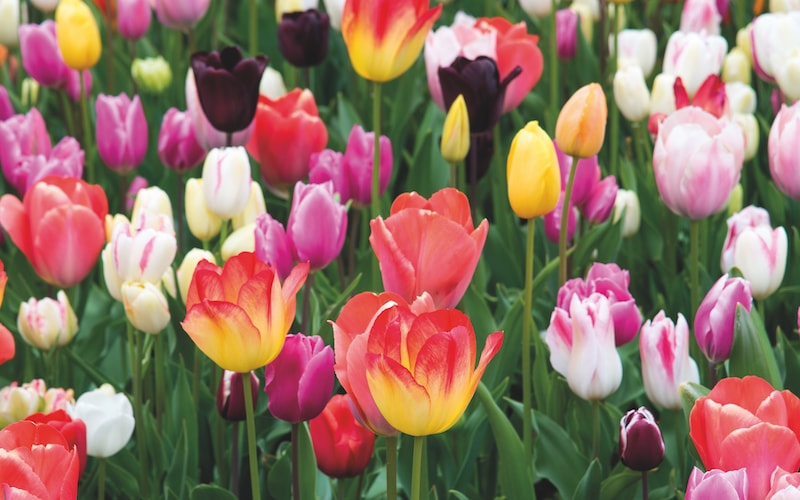One of the most spectacular spring-flowering bulbs, tulips dazzle the post-winter garden with their bright blooms. Plant these hardy bulbs in beds, borders and containers for a joyful burst of colour and fragrance come spring.
From delicate native varieties to scented giants, browse our full collection of tulip bulbs here. When you’ve made your choice, here’s everything you need to know about growing them.
What are tulips?
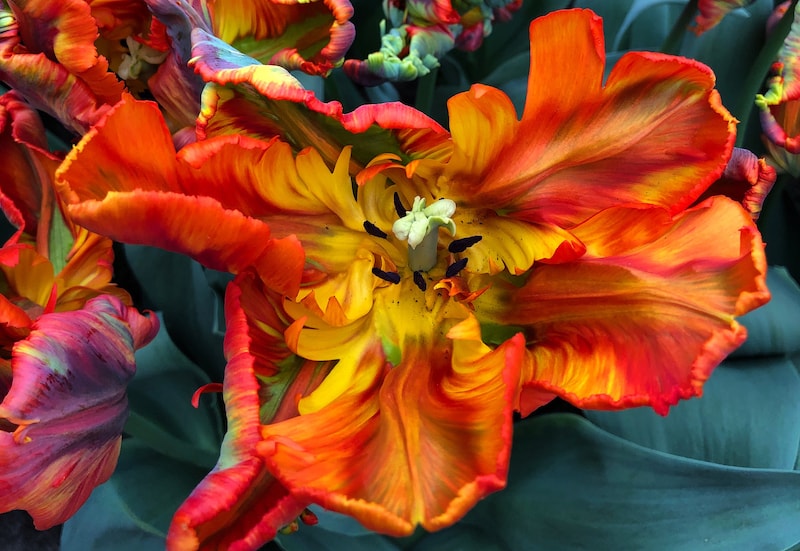
Parrot tulips produce large flowers with fringed edging
Image: Tulip ‘Rasta Parrot’ from Suttons
Tulips are vibrant, perennial flowering bulbs available in punchy reds through to delicate pastel pinks. They flower from mid- to late-spring alongside other popular bulbs like daffodils, narcissi and early alliums.
First introduced to the UK during the ‘tulip mania’ that swept through 17th century Europe, they’re back with a bang in modern gardens. Grouped by flowering time, it’s easy to buy a mix of early, mid-season and late-flowering varieties to prolong the colour. Here are some our our team’s favourites right now:
- Tulip ‘Angelique’: These large, pale pink, blousy flowers look best in groups, or picked and displayed indoors in a vase. Plant in containers near your outdoor seating area to enjoy the fragrance.
- Tulip ‘Greenland’: Grow this if you’re after a tougher flower. The eye-catching green and pink petals show superb weather resistance and make a great mid-spring splash in your herbaceous border.
- Tulip ‘Flaming Club’: Create a thick carpet of colour with these multi-headed stems. Plant en masse for a striking mix of white and cherry red.
When to plant tulip bulbs
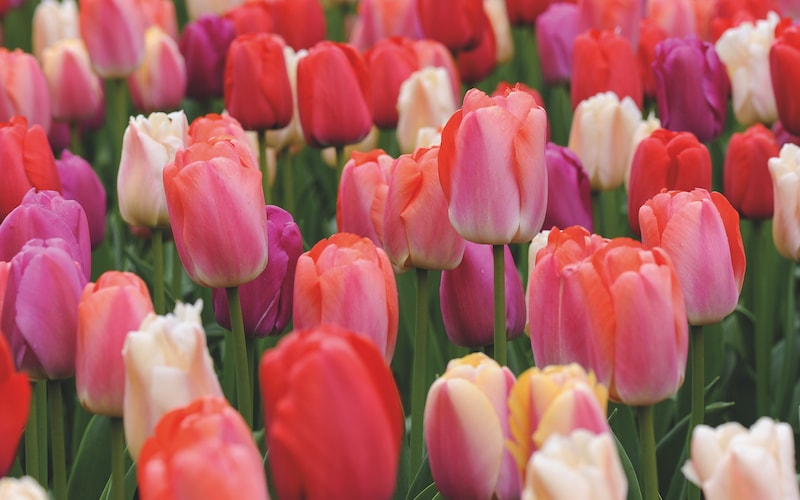
Tulips look their best planted in drifts of the complementary colours
Image: Tulip ‘Sunset Shades’ from Suttons
For the best results, plant your tulip bulbs in November. You can plant them from late October through to the end of December, but you’ll need to get them into the ground before it freezes. Your tulip bulbs need a cold spell underground to reduce the likelihood of disease.
Where to plant tulip bulbs

Plant Tulip ‘Murillo Mixed’ in the front of borders for stunning displays of early spring colour
Image: Tulip ‘Murillo Mixed’ from Suttons
When planting your tulip bulbs in the ground, choose a sunny spot with free-draining fertile soil. Group your bulbs together in the middle of the border to enjoy the best impact when they flower. To bring out a tricky dark area, go for a variety with luminous white blooms like tulip ‘White Prince’.
As a rule, avoid exposed areas. If you have a wind-prone garden, a short-stemmed variety like the pretty bicoloured tulip ‘Ice Stick’ may do better than a long-stemmed one. Alternatively, plant your new bulbs into a container and shelter them behind a wall or fence. Use a peat-free multi-purpose compost with a few handfuls of sharp sand or horticultural grit to improve drainage.
For a super long-lasting display of colour from your spring containers, use your tulips to make a spring bulb ‘lasagne’. The layers of large, medium and small bulbs like crocus and daffodil emerge one after the other throughout spring. If you’re interested, see our article ’How to grow spring flowering bulbs’ to find helpful planting tips.
How deep should I plant tulip bulbs?

Tulips have a stunning impact when planted in blocks of the same colour
Image: Tulip Pink Giant from Suttons
As a rough rule, plant your tulip bulbs deeper than you would other spring bulbs, aiming to get them at three times their own depth with the pointed end facing up. Tulip bulbs that are deeply planted are safer from pests like slugs and have a better chance of repeat flowering the following year.
Use a special bulb planter to help you get the right depth. The tool removes a core of earth, allowing you to drop your tulip into the soil and then easily re-cover. Create a fantastic natural look in grass by dropping a handful of bulbs and burying them where they fall.
How to care for tulip bulbs
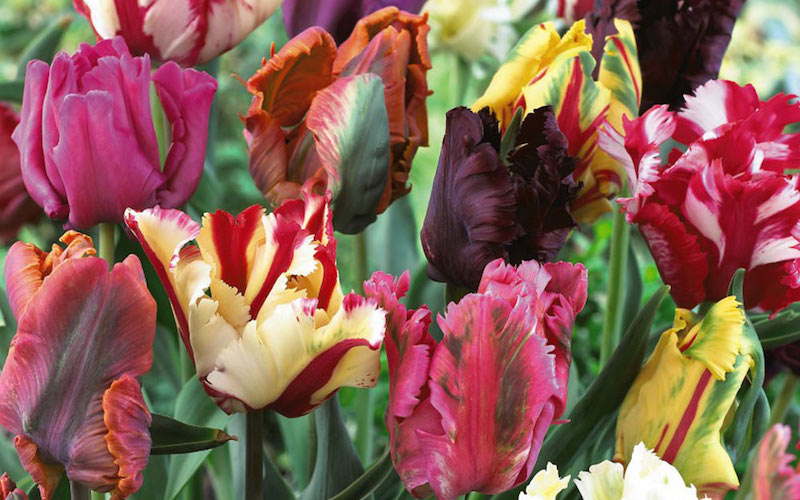
There are so many tulip varieties to choose from, like the unusual Tulip ‘Parrot Mixed’ from Suttons
©Visions BV, Netherlands
Straight after planting your tulips, give the soil a good water to settle it snugly around your bulbs. Keep the surface weed-free to remove any competition for water or nutrients. You can expect to see the tips emerging from the soil in early spring. As they develop, keep your bulbs moist but never allow them to be waterlogged.
As the blooms burst in April and May, cut a few heads to enjoy indoors. If you’ve planted a container display, move your pots into a prime position to enjoy their full impact. When bad weather is due, simply cut your blooms to enjoy indoors or move the pots into a more sheltered spot until it’s over.
What to do with tulip bulbs after flowering
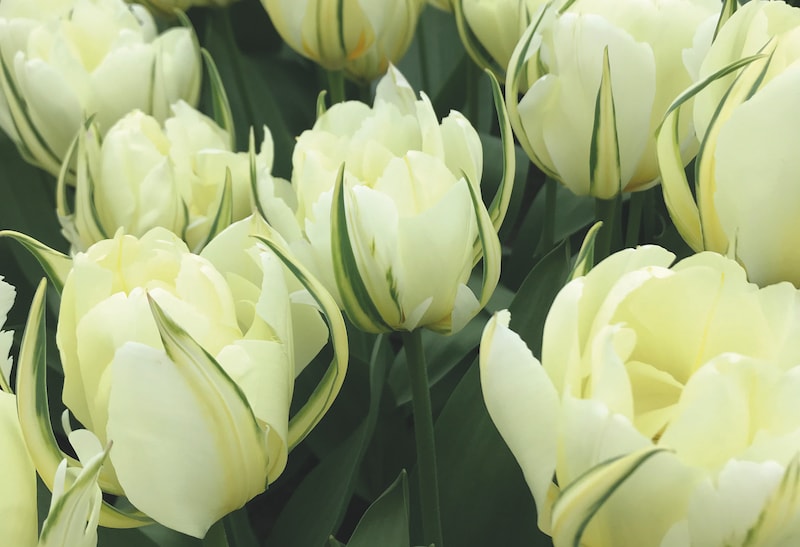
Plant pale coloured or white tulips to highlight a dark spot
Image: Tulip ‘White Valley’ from Suttons
As your flowers start to fade, cut the stems using sharp secateurs. This prevents seed heads from forming and prevents your bulbs from using up vital energy that can otherwise go into next year’s flowers. Leave the foliage to yellow and die back naturally. However, if you’re growing native tulips with the goal of naturalising them, leave these to to form seed heads so they can self-seed and spread.
When your container displays have finished flowering, you can re-use the pots by emptying out the bulbs and storing them through summer. Clean excess soil from your bulbs gently with a brush when they’re dry and store them in a cool dark space until November when they can be planted again.
Tulip flowers brighten any garden space with top colour in spring. They’re easy to grow when you know how! Take a look at our expert advice on growing tulips to see what our favourite online bloggers have to say about growing these spectacular flowers. And if you’re after more gardening gold, our growing guides have plenty of advice to help you fill your beds with flowers all year round.
Lead image: Tulip ‘Triumph Mixed’ from Suttons
Last Updated on August 26, 2025 by Suttons Horticultural Team

